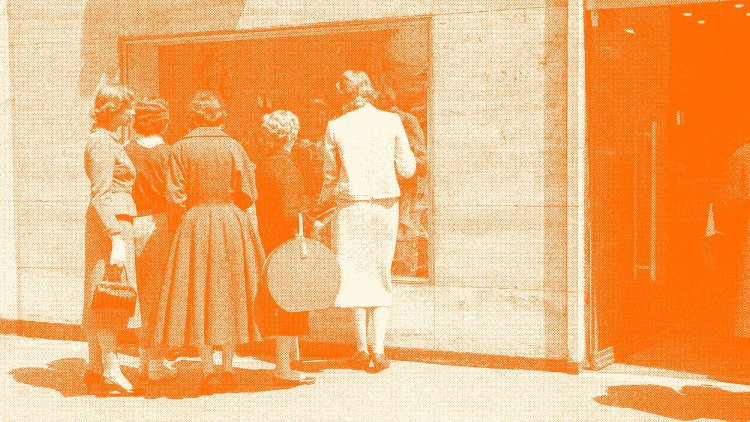Shopping Shouldn’t Be Instantaneous
A bit of inconvenience can be useful.

This is an edition of Time-Travel Thursdays, a journey through The Atlantic’s archives to contextualize the present and surface delightful treasures. Sign up here.
In 1931, an Atlantic contributor named Frances Taylor begged stores to take her money. Her long rant about a shopping expedition gone awry describes a failed attempt to buy pajamas (the ones she found had no pockets—a disaster—nor did they come in her size); a lamp with a yellow or blue shade (the only one available is “pink and broken,” she is told); and most of the other items on her list. “Busy women have money to spend; make it easier for them to buy and they will spend it,” she wrote.
Taylor offered some suggestions, both realistic and less so, for how the department stores of the time could offer more convenience to customers. But most fascinating is her description of the problem: “I don’t like to shop, but I do like to buy.” What Taylor dreamed of, it seems, was a life of making instantaneous purchases, no thinking required. If only she could spend five minutes on Amazon.
But the department-store experience of the 1930s was in some ways familiar to our one-click online-shopping era. In a robust response to Taylor’s anti-shopping screed a few months later, the contributors Helen Peffer and Juna Newton argued that, for well-off shoppers, impulse purchases were far too easy to make. “Nowadays most department stores operate under the policy, ‘The customer is always right,’” they noted. One result of this policy was an excess of returns: “Well-to-do” female shoppers “purchase seven neckties and return six,” they wrote. “They telephone or write asking that drivers call and pick up tooth paste, cigarettes, toilet paper, or two rolls of dental floss.” The resources needed to return so many items, free of charge, was a strain on department stores. (Among the article’s examples of returns gone wild: “In a small New Jersey town there actually lives a woman who bought her husband a suit of underwear in October 1929, and asked to return it in November 1930. She said it wasn’t ‘wearing well.’”)
Returns have gotten only more common since then, but today’s stores have found ways to free themselves of some of the logistical and financial burden. Amanda Mull reported last year that many brands were beginning to charge customers return fees or require that they cover return-shipping costs. (ASOS, H&M, and Zara are among the latest popular stores tacking on a return fee for some customers.) “Convenience is always expensive for someone,” she wrote. “For much of the internet era, the individual buyer hasn’t been footing the bill, but slowly, that has begun to change.”
The prospect of paying for returns, Mull noted, might lead the shopper to spend a bit more time thinking before they make a purchase—that is, if they clock the company’s return policy in the fine print. “Buying things online has never been so simple, so seamless, so easy. So easy, in fact, that we might all be better off with a few more speed bumps,” she wrote in another article last year. I can hear Taylor’s voice in protest: Just let me give you my money! But maybe human beings were never really meant to buy without enduring some shopping first.
The Atlantic’s archives are a reminder of a time when shopping was typically a public and social experience. In their 1931 article, Peffer and Newton posited that “it is probably true of most returners that they buy things which they neither need nor want, simply from an inherent love of shopping. They think of shopping as a diversion rather than as a serious business.” Shopping was an activity in and of itself, appealing even to shoppers who didn’t intend to keep the items they bought.
And many shoppers cared how their purchases looked to other people: In a hilarious account of his first visit to a supermarket in 1954, the writer Weare Holbrook was delighted to lose himself in the crowd, avoiding the prying eyes present in a smaller grocery store. “The average adult male,” he wrote, “cannot easily bring himself to ask his grocer” for items such as “Kinky Winx cereal, Whipsy Doodle salad dressing, Dreamboat soap, O-So-Lushus cake mix, Lover Boy lard, and Icky Poo pre-whipped cream.” The supermarket’s advantage over its smaller competitors, he noted, is that “it is impersonal.”
Today, of course, grocery shopping is one of the only kinds that still regularly occur in public—at least until grocery-delivery services completely take over. The rest of our shopping more often happens on our phones, while we wait in line for coffee or scroll before bed. (I admit, though, that I am one of those Millennial holdouts who prefers to make big purchases on my laptop.) We’ve lost the “speed bumps,” the necessary pause when we ask ourselves: Do I want this? Do I need this? Can I afford this? Thinking through those questions won’t give us full control over our shopping decisions, as algorithms and marketing tactics work overtime to tell us what we want. But wresting back a little independence might make the final purchasing click feel even better.
What's Your Reaction?




















